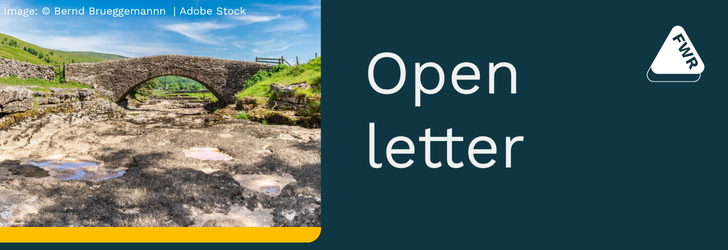This year saw the driest start to the year since 1976, with 20% less than the long-term average rainfall falling in June across England, with large areas of the country facing drought conditions. The National Drought Group met on the 11th August to discuss the water shortfall situation in England, which was defined as a “nationally significant incident.”
The Foundation for Water Research (FWR) fully supports the actions taken by the members of the National Drought Group to protect water resources and the environment. However, the FWR feels that the narrative concerning the reasons and triggers for the introduction of drought control measure must be made more visible to the public. This will support greater transparency around water resource management, helping to bring the public along with decisions and increase trust between the public and the water industry.
For this reason, the FWR is calling for Regulators and Water Companies to provide the public with real-time water resources data, providing information on reservoir, river and groundwater levels for abstraction points and the drought position for each water resources zone in relation to their triggers for action in their drought management plan, all on one interactive map.
This will allow members of the public to be able see the current status of a water resource zone against the relevant water company's published drought plan criteria, in any region of the UK.
Effective public engagement is vital to supporting improved water resources and demand management. Increasing transparency through publicly accessible data around water resources and related decisions will be a key tool for supporting public engagement and rebuilding trust. This would help in programmes to reduce consumption and would also improve the understanding of the need for future sustainable water resources management. At present, there is no clear picture of the status of water resources from catchment to catchment, or why some areas are more affected than others. Whilst some water resource information can be found on company websites, it is normally several weeks out of date and hard for a member of the public to find.
By using the model of the Sewer Overflow Map, water resources information can be made easily accessible to the public. Crucially, the data needed to produce a water resources map is already collected by water companies, typically every 15 minutes. The availability of this data will make the development of a Water Resources Map much easier than the Sewer Overflow Map (which at the time did not have the relevant data routinely collected). Similarly to the Sewer Overflow Map, a Water Resources Map should be funded by water companies, on the direction of Ofwat and the Environment Agency.
Contact
Ethny Childs, Head of Communities and Partnerships, ethny@the-ies.org.
Background
Since its founding the Foundation for Water Research (FWR) has helped to educate the public in science, engineering and the management of water. The FWR’s work brings together professionals from across the water sector and related scientific specialisms for deliberative discussion to support the development of interdisciplinary solutions to water challenges. The FWR is led by a Committee and three Technical Panels, including a Water Resources and Quality Technical Panel with experts in water resources management.
The Community has representatives from across the water sector, spanning industry, academia, consultancy, regulators and NGOs. They provide a unified voice across the sector and are part of the Institution of Environmental Sciences (IES) family, the global professional membership body for over 6000 environmental scientists.
Sign up for the FWR's free mailing list to stay up to date with it's work.



